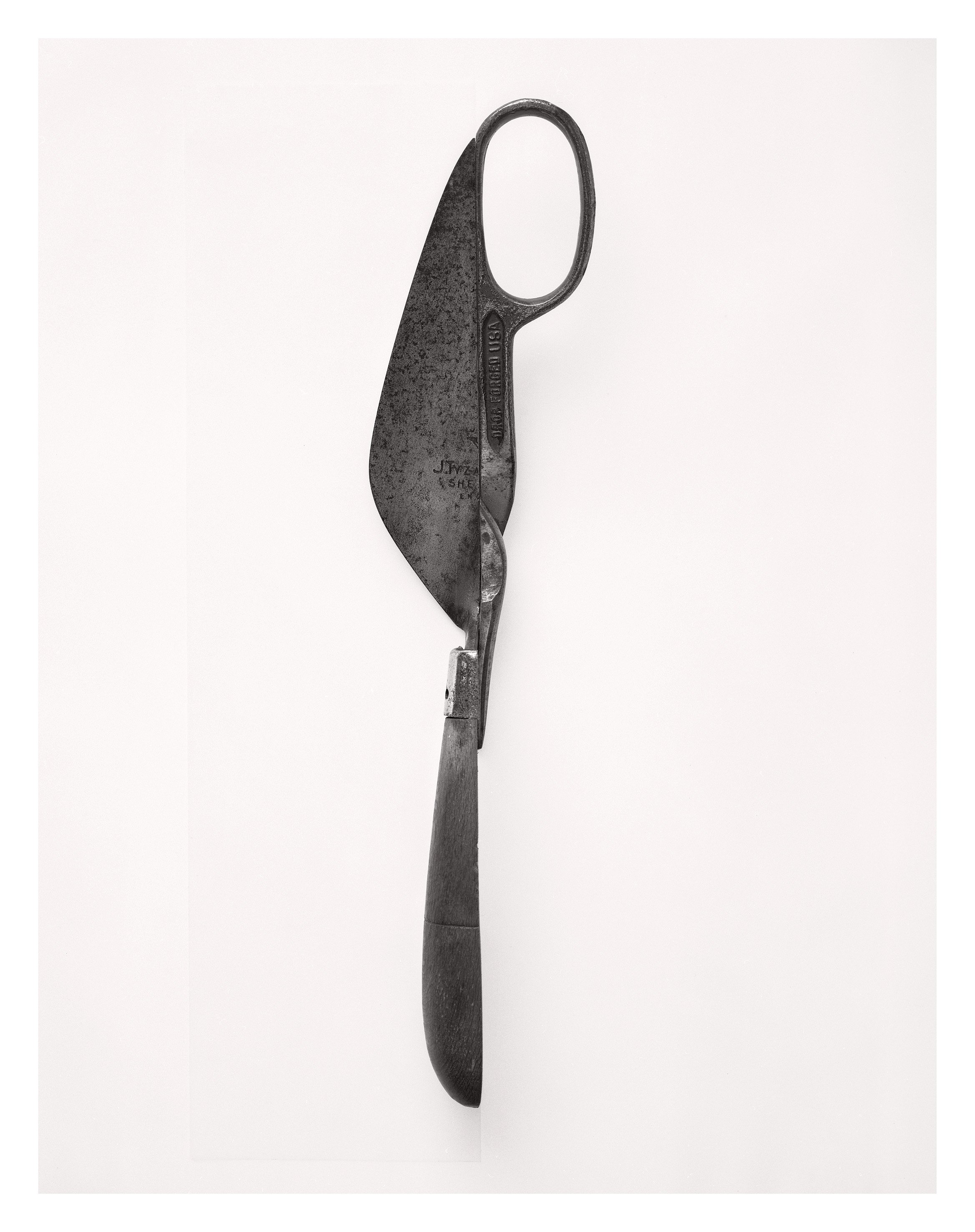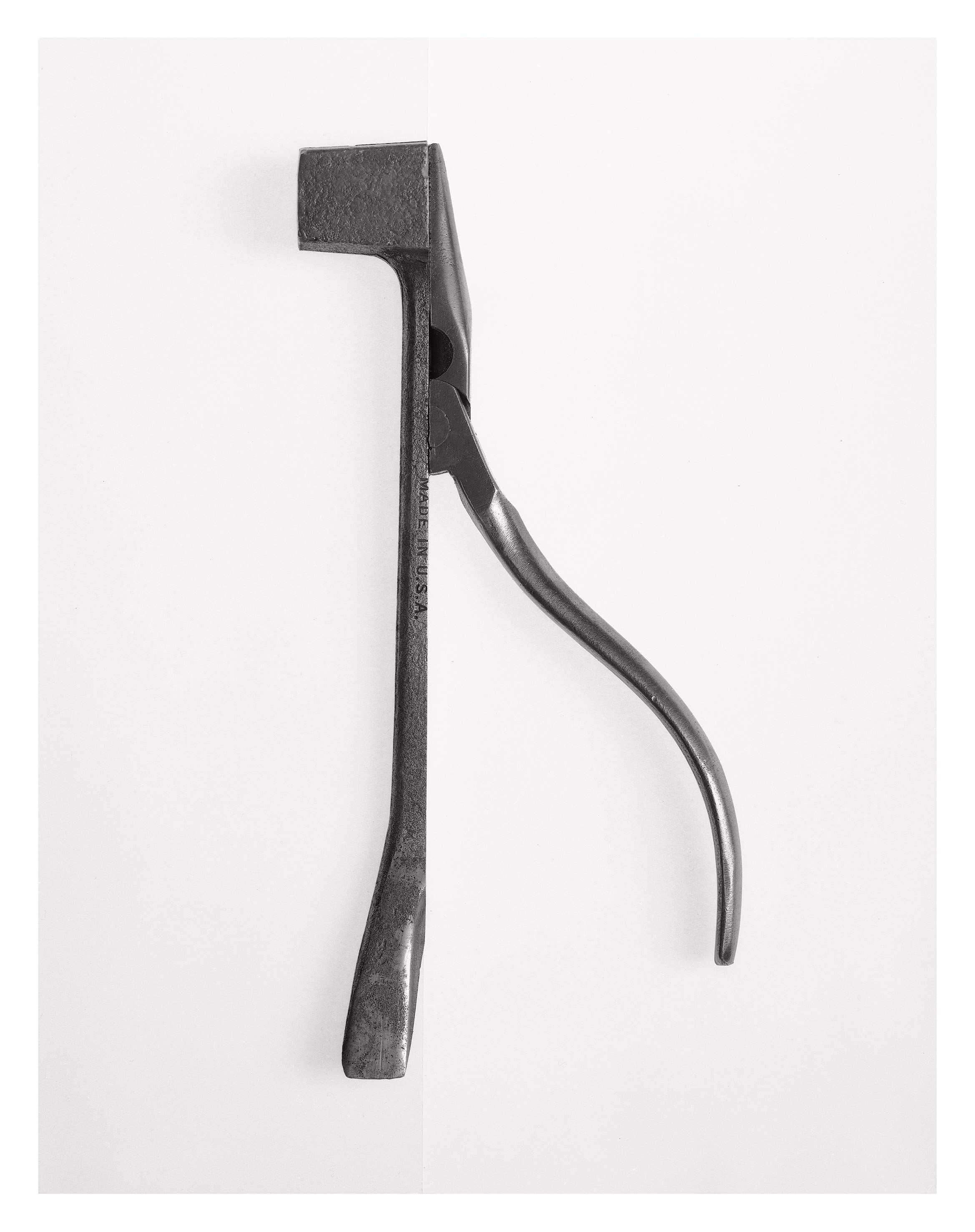Materialising
fictions of image / facts of material





Beauties of the Common Tool, Rephrased
Fibre-based handprints, 87 x 69cm, 2013
A set of photographs by Walker Evans has been digitally montaged together to make new forms before recreating these image constructs in reality, sourcing, cutting, and rejoining matching tools. The resulting hybridised physical objects are photographed to create the final work, entailing–in part–a reversal of photographic trajectory: where photography typically starts with something in the world and makes an image of it, here pre-existing images have been made into something in the world.
Walker Evans, Beauties of the Common Tool, Fortune Magazine, 1955
Grounds of Doubt
Lambda print, 147 x 69cm (framed), 2011
More or Less Obvious Forms
C-type handprints, 2012
(L)61 x 54, (M)70 x 56, (R)56 x 45cm
Objects are hand-painted with the checkerboard pattern Photoshop uses to signify empty space. Photographed from one exact perspective the pattern becomes two dimensional. Visual properties that initially appear to belong to the image are rather those of its subjects.
Phrasings
Wall-mounted rock with resting framed C-type print (57 x 46cm), 2013
Print detail
No Lemons No Melon
Surface, line and form continually interchange, transposed through drawing, material, and photography.
Led purely by form a source image was created (fig.1) and an internal geometric shape derived and extracted from it (fig.2). The geometric operates on universal principles and, as such, the form alters perspective in rotation–concave to convex.
Three dimensional pairings were created to materialise these opposed viewpoints through the camera lens (fig.3), the precision of geometry filtered through the wanderings of visual perspective (fig.4).
An image of the combined forms (fig.5) was flipped and hand-drawn back onto the three dimensional object. What now seems a multiple exposure is the direct photograph of the object, presented here twice (fig.6): one image is rotated but without it being obvious which is which. The second and third dimensions–photographed form and drawn form–are continuously conflated.
fig.2
fig.1
fig.3
fig.4
fig.5
fig.6
fig.1: Source, 70 x 56cm, Resin print on MDF, 2017
fig.2: process images
fig.3: Unique polaroids, 2016
fig.4: untitled, Fibre-based handprint, 2017
fig.5: process image
fig.6: untitled, Lightjet print, 78 x 52cm, 2017
The Halt
C-type handprint with axe, 54 x 43cm (print), 2011
Verisimilars
Fossil, C-type handprints, and book page in wooden vitrine 123 x 43 x 10cm, 2013
The page from a children’s learn-to-count book asks how many things we can see that are the same? While nothing presented is exactly the same the closest would be the two photographic prints: all their properties – bar some chemical colouring on their surfaces – are otherwise identical. This in spite of their appearances being so different.
When Is An Image Not An Image
Fibre-based handprint mounted on MDF, 54 x 43cm, 2013
A photograph of forms is mounted back onto the material it depicts. A bevel in the MDF makes two sides of a frame, shadow cast from a light installed in the gallery creates the others; each element of the ‘frame’ depicts the image subjects as well as highlighting - through colour and light direction - its difference as object.
Relation
Fibre-based handprint, 52 x 42cm, 2011
Proximities: source (surface)
source (surface)
C-type Lambda print in tray with bulb and table, 52 x 42cm (print), 2011
Combining the image and its source through reflected light. In Source (Surface) the light from a bulb is both reflected into an image of that same bulb, or seen floating free of it.
In Surface (Source) the lit bulb rests on the photograph itself, its printed image being of light reflected in black photographic paper. Image and actual world conflate.
Both effects depend on the physical proximity of the viewer.
Quotations In Kind:
quotation in surface / quotation in solid
Surface: C-type handprint, 93 x 75, 2014
Solid: one piece cast concrete, 70 x 40 x 40cm, 2013
Found book
Surface and solid both ‘visually quote’ a reference image from a children’s book. While the book teaches counting it simultaneously teaches the reading of images. How many bricks? There are only image surfaces and one shaped form, so technically none.


































